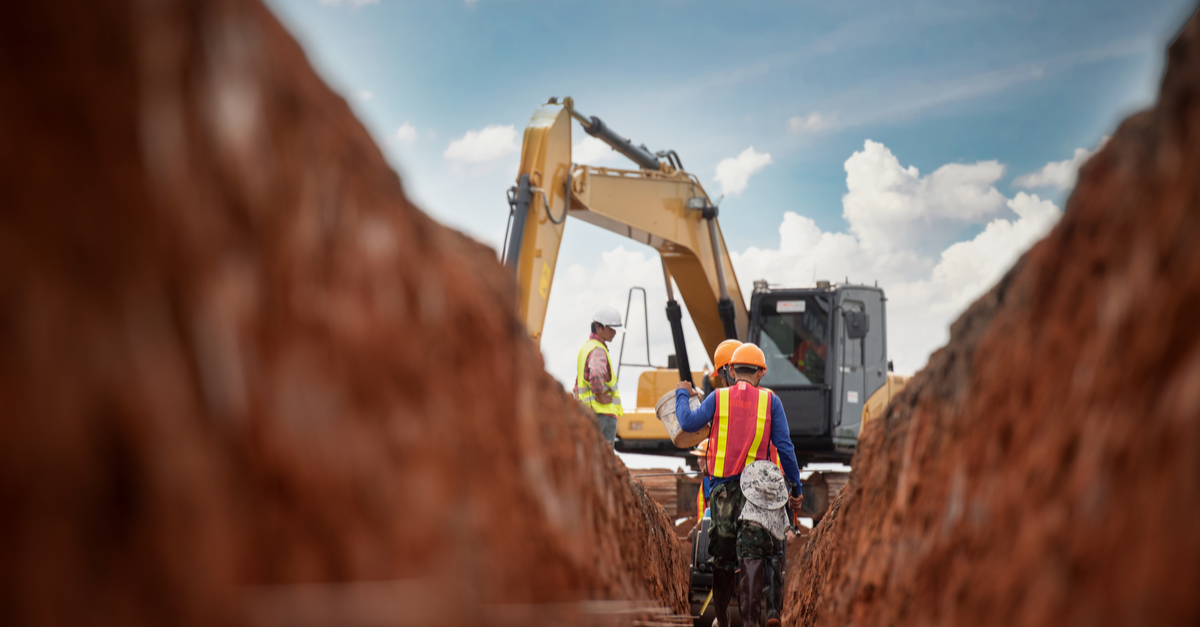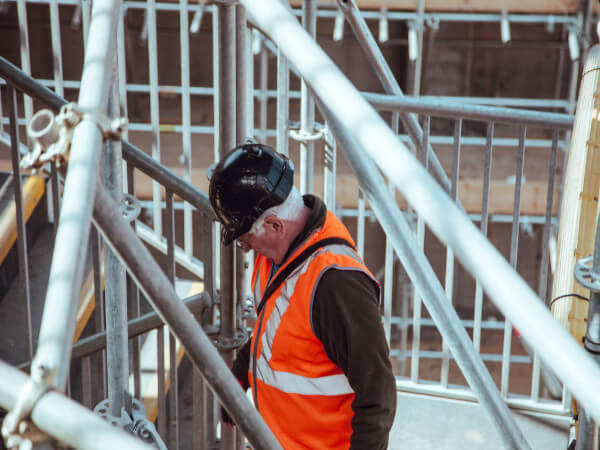Home » Construction Management
Category Archives: Construction Management
June’s Nonresidential Construction Starts +14% M/M, But -11% YTD

A Compelling Megaproject Story
ConstructConnect announced today that June 2021’s volume of construction starts, excluding residential work, was $38.4 billion (green shaded box, Table 8 below), an increase of +14.4% vs May 2021’s $33.6 billion (originally reported as $32.5 billion).
![]()
2021 in Review: Europe and the Middle East’s Year in Construction

As the end of 2021 fast approaches, we have begun to look back on another challenging – but exciting – 12 months in construction.
At the end of the most disruptive year on record – 2020- we knew there would be challenges and changes ahead. The lasting effects of the Covid-19 pandemic continued to make its mark on the world over, but the news and rollout of vaccination programmes brought us much needed hope. And with the continuing impacts of Brexit, climate change and skills and labour shortages, there is no doubt that construction firms were keeping their resiliency plans firmly at the front of their minds.
However, it’s safe to say that we again couldn’t have predicted the long-term impact of Covid-19 on our sector with further lockdowns across much of Europe as we entered 2021 which not only halted productivity and project progress but also contributed to a global materials shortages.
As ever, many businesses, technology has remained mission-critical but the way in which companies are adopting to this is bringing back some clear competitive differences across the market. We’ve brought together experts from our Autodesk Construction Solutions (ACS) team in Europe and the Middle East to share their thoughts on the year we’ve had and what we’ve learned.
Digital plans evolving from survival mode to long-term business strategies
For many construction companies in 2020, digital ways of working were forced upon them to keep afloat. Investment in solutions to keep operations moving in such uncertainty become a necessity and companies with long-term digital strategies were able to keep focused and in places, accelerate their goals.
District Manager for DACH, France and Spain Marvin Theissen reflects; “A Common data environment is always key in effective collaboration when it comes to remote working, and many companies recognised this in 2021. Despite this, 2021 also demonstrated that layering product and solutions on top of each other without a clear strategy can lead to systems fatigue for end-users.”
But as Nordics District Manager Nicholas Klokholm explains, “Companies are becoming more sophisticated in their needs and their employees expect this. Project teams want to work more holistically rather than using point solutions, and this will enable them to capture and use their data for better insights.”
New ways of working creating competitive advantages
When it comes to the marketplace, owners and main contractors also expect to experience a more streamlined digital experience when it comes to viewing and collaborating on their projects. Data that is captured in one place and used to provide richer insights can help decision-makers on projects.
Sander Lijbers, District Manager at Autodesk for Benelux says, “2021 was the year for refining and improving the use of technology. Companies that did this and could demonstrate it had a competitive edge when it came to bidding for work in our industry. Having a central source of truth shows project owners that risk and uncertainty are being addressed and reduced which is some of their biggest concerns.”
Shortages in materials and labour leading to skills in demand
The materials shortages that plagued the industry for much of 2021 is unfortunately here to stay. As cost of materials skyrocket and delays seep into schedules, a focus on skills in the industry emerged. For Europe, the major effects of Brexit are starting to impact the labour market. Demand for construction workers across the UK steadily increased throughout 2021 as migration over Europe changed in light of new Brexit legislation.
According to Account Executive for UK & Ireland Brian Roche, the demand on skills led to project pressures and more competition within the market. “Employees expect to work more flexibly in line with other industries. The rise of remote working in 2020 showed us that collaboration can continue regardless of your geographical location with the right tools to support you, and this will be a decision-making factor as skilled workers look for roles within the industry.” Firms working with paper-based and manual processes run the risk of being left behind when it comes to attracting and retaining top talent.
Senior Customer Success Manager in the Middle East, Mohammad Abou Assali recognises that now more than ever, the workforce is looking closely at the mission and values of companies ensuring they align to their own. “In both 2020 and 2021, key issues in the world really came to the forefront. And the time to respond and make change is now. The construction workforce is increasingly aware of their own priorities and want to see more from the industry when it comes to reducing our carbon footprint, so companies need to show their own commitment and advancements towards changing for the better. If they don’t, they risk losing out.”
People remain at the heart of the construction industry
Despite great progress in digitising and modernising the construction industry for the better, people will forever remain at the heart of the industry. Regardless of the technology being deployed or workflows established, people and their experience must be placed at the centre of any change. As District Manager Nicholas Klokholm says, “Change is difficult, and it doesn’t just happen. Data needs to be the enabler for all that we do in this industry and it is the driver for change.” For Sander Lijbers, District Manager for Benelux, 2021 was the year for preparing for the future; “Getting your own organisation in order was a key priority in 2021 and if you didn’t do that then 2022 is the time to do it – this way you’ll be ready for what is to come next.”
The post 2021 in Review: Europe and the Middle East’s Year in Construction appeared first on Digital Builder.
Top 10 Major Upcoming Entertainment Facility and Stadium-Arena Construction Projects – U.S. – July 2021

The accompanying tables show the top 10 major upcoming entertainment facility and stadium-arena construction projects in the U.S. They are all in the planning stage and are mainly new projects, but may also involve additions and/or alterations.
![]()
Did you miss our previous article…
https://www.arizonasolarsociety.com/?p=1765
Why Your Least Enthusiastic Team Member Should Be Your Safety Software Champion

Every team has a member who operates the lowest level of enthusiasm possible. Their go-to response to any deviation from the current plan is “I’m fine this way,” even with simple process changes.
![]()
Did you miss our previous article…
https://www.arizonasolarsociety.com/?p=1737
The U.S. and Canadian Inflation Story in Seven 1,000-Word (Standalone) Graphs

The seven (potentially) standalone graphs in this article show how inflation, according to the traditional Consumer Price Index (CPI) means of measurement, has been heating up in both the U.S. and Canada.
![]()
Did you miss our previous article…
https://www.arizonasolarsociety.com/?p=1702
How to Win More Construction Bids in 2022

Are you looking to win more construction bids in 2022? Maybe you’re planning to grow and scale your construction business in the new year or perhaps you’re just looking to be more efficient in your estimating and bidding process to improve your bid-hit ratio.
![]()
Did you miss our previous article…
https://www.arizonasolarsociety.com/?p=1651
Construction Worker Deaths Decreased in 2020

Good news. The number of fatal occupational injuries for the construction industry declined in 2020. The number of construction worker deaths in 2020 was 1,008, a 5.3% reduction from the 1,061 fatal work injuries in 2019.
![]()
Did you miss our previous article…
https://www.arizonasolarsociety.com/?p=1647
The Future of Work is Now: Is the Construction Industry Ready?
In early 2021 Deloitte was commissioned by the Autodesk Foundation to help identify the labour markets most vulnerable to technological disruption in the Asia Pacific region. The report, The Future of Work is Now: is APAC Ready? Identifies those most at risk and proposes interventions which can be scaled and adapted to different circumstances across our region.
The current COVID-19 pandemic, and the challenges it has brought, has accelerated digital trends. Heavy restrictions have been faced in Melbourne and Sydney throughout the year, and this has caused us to consider:
- New models of work throughout the economy
- Specific to construction, new methods of connecting with each employee and team from the office to onsite across the workforce, and through our supply chain
- The demand drivers for more employees; however, there has been a real dichotomy with restricted activities as this has made it hard to find workers
Figure 1: Number of people employed in Australia (‘000s)

Source: Australian Bureau of Statistics, Deloitte Access Economics
Figure 2: Job ads index, 100=decade average to Nov-19

Source: Australian Bureau of Statistics, Deloitte Access Economics
Considering the last point, finding and retaining skilled workers has been an ongoing concern. The number of job advertisements as reported by the Australian Bureau of Statistics and Deloitte Access Economics have risen highly in all sectors and stayed at high levels, and unemployment is at an all-time low in Australia.
Figure 3: Number of unemployed persons per job vacancy

Source: Australian Bureau of Statistics, Deloitte Access Economics
This year we have experienced a dual labour market where some could not work due to restrictions, while some are adjusting to new roles, and many businesses still could not fill vacancies. In October this year, Infrastructure Australia released their Infrastructure Market Capacity report which stated that up to 105,000 well-paid jobs risk being unfilled by 2023 due to global competition for workers.
Infrastructure Australia forecasted a shortage of 70,000 engineers and architects, 15,000 structural and civil trades, and 19,000 Project Managers. This makes the sector one of the hardest hit, with looming skills gaps on public projects across the country, putting more pressure on already-stressed budgets and time frames. This impact has a knock-on effect to other parts of the commercial construction industry as the sector aims to become an industry of first choice for entrants.
Automation in Construction
The Future of Work report covers three core components:
- Impacts of automation going beyond likelihood of automation
- The readiness for automation and how countries are prepared, and
- Initiatives to take action as one size does not fit all, particularly across the APAC region
Construction topped the list as the industry most likely to be hardest hit by the coming wave of automation. The industry had the highest proportion of routine, manual tasks, with a high potential for automation.
Figure 4: Impact Index result by industry

It’s also noted that Australia is the most prepared and second least at-risk country from automation. Its investment in its future workforce is a significant contributor to this result. However, as noted above, the future workforce is still at risk. Continued investment is needed, particularly in upskilling, to stay in this position and help ensure our country remains competitive in the region.
Figure 5: Potential impact of automation and preparedness, by country

To be in the best position to benefit from automation, individuals, businesses, countries and regions need to focus on three key opportunity areas. These are identified as foresight and mindset, skills and learning, and access and inclusion.

Based on The Future of Work research, there are four key insights about how to address the skills gap:
- While training for highly specialised skills will be essential, it’s more important to shift the skills development focus to foundational, analytic, problem solving, creative and collaborative capabilities that can be transferred from role to role – because the shelf life of specific skills will continue to shrink.
- The pace of change means workers need to engage in continuous skills upgrades – that’s how they will ensure stability, and it will require them imagining and navigating a very different career path.
- We must shorten the distance between learning and work, which means embedding learning into the workplace by enabling workers to study new skills and experience different environments.
- Addressing systemic challenges: government, industry and academia need to work better together to help people get the right skills to fill these open jobs.
Addressing the skills and capabilities gaps
There are opportunities available that organisations like Autodesk can address with industry to close the gaps identified in the research, taking into account current market conditions. At Autodesk, we approach it with three things in mind:
- What TRAINING can we put in place to allow people to constantly upgrade their skills?
- What TOOLS help shorten the distance between training and work?
- And how should private sector, public sector, education institutions, among others, PARTNER to address the systemic challenges in collaboration?
Training
To support training, Autodesk launched our new learning and credentialing platform at Autodesk University last year. The platform is designed to make training personalised and transformative. Workers can get credentials on their terms and timelines and build personalised learning pathways that help them develop the skills they need.
Autodesk credentials make learning more accessible, measurable, and relevant for customers. Industry recognised certifications help workers to market their job readiness. Whilst the sector has foundational entry-level qualifications, the opportunity for partnerships that support the business with micro-credentials enables practical courses that can address the needs of the company.
Tools
Autodesk Command Map is designed to watch how you use the Autodesk products, highlight the areas in which you’re proficient and the areas you need to improve on. It also offers benchmarks against industry standards to help you focus in the right areas and to use the tool to its full potential to reap the rewards of the investment.
Collaboration
This takes many forms and is arguably the most complex because it takes many different parties to address the systemic problems. According to the World Economic Forum, a collaborative effort could reach 77% of all workers that need reskilling – versus just 25% if the private sector were to do this alone.
The Future of Work is Now
At Autodesk, we believe that automation technology, including artificial intelligence, will be required to help businesses and society meet the demands of our growing urbanisation and global population. We recognise that technological change will drive transformation – and we are committed to helping companies and their employees adapt and thrive. We believe employees prosper by adopting a mindset of continuous learning, acquiring the most in-demand skills and securing the most fulfilling roles. We are committed to collaborating with employers, the start-up community, the vocational education and training sector, universities and government organisations to advance workforce adaptability, as we invest in solutions and policies that complement employers and employees to adjust in an ever changing environment.
Autodesk can support you and your organisation. The Future of Work report can be accessed here.
The post The Future of Work is Now: Is the Construction Industry Ready? appeared first on Digital Builder.
Autodesk to Acquire Cloud Based Estimating Company ProEst

ProEst will join Autodesk to strengthen its preconstruction offering and connect the project cost lifecycle within Autodesk Construction Cloud
SAN FRANCISCO, Calif., Dec. 16, 2021 – Autodesk, Inc. (NASDAQ: ADSK) today announced that it is acquiring ProEst, a cloud-based estimating solution that enables construction teams to create estimates, perform digital takeoffs, generate detailed reports and proposals and manage bid-day processes. Autodesk plans to integrate ProEst with Autodesk Construction Cloud, a comprehensive construction management platform connecting teams, data and workflows across the entire building lifecycle. The acquisition will strengthen Autodesk Construction Cloud’s preconstruction offerings and empower construction teams to manage all their critical preconstruction and construction workflows on one platform.
ProEst, whose customers include Geisinger, O’Brien Construction, Vantis and Oswald, translates project scope quickly and easily, turning drawings, specifications and models into material, labor and equipment costs. As a result, teams are not only able to supercharge the estimation process and build stronger bids, but also minimize project risks and heighten their chances of winning work. With ProEst’s cloud-based solution, customers can also access estimating information from anywhere, at any time, and import third-party cost databases to streamline estimation workflows. The acquisition of ProEst will complement Autodesk Construction Cloud’s best-in-class cost management capabilities and allow teams to track costs against estimates and provide greater visibility to increase the probability of project success.
“We pride ourselves on delivering quality projects safely, within budget and in a timely manner,” said Luis Berumen, vice president of innovation and technology, Bartlett Cocke General Contractors. “Autodesk Construction Cloud helps us manage our projects by enhancing collaboration across various phases and workflows and adding ProEst’s cloud-based estimating capabilities to the mix will further our ability to deliver quality projects efficiently.”
“ProEst enables us to produce estimates faster, consistently and more accurately throughout the design process and in collaboration with our partners, thereby improving overall efficiency” said Manny Innamorato, chief information officer, New York City School Construction Authority. “As a public entity, our mission is to build and modernize New York City’s schools in a responsible, cost-effective manner while still achieving the highest standards of excellence in safety, quality and integrity. With Autodesk Construction Cloud and ProEst now joining forces, we look forward to connecting our estimation data more seamlessly with our downstream construction workflows so we can stay on track and deliver on our mission in a more streamlined manner.”
ProEst will join Autodesk Construction Cloud’s existing portfolio of solutions, further enabling teams to reduce rework, improve productivity, increase automation and accelerate project delivery. Autodesk Construction Cloud solutions include:
- Autodesk Takeoff: empowers estimators to perform 2D and 3D quantification workflows.
- Autodesk BIM Collaborate: enables project teams to align on and execute design intent by managing design collaboration and coordination workflows from a single solution.
- Autodesk Build: connects project, cost, quality, safety and field collaboration workflows in a solution that is easy to deploy, adopt and use.
- BuildingConnected: centralizes and streamlines the bidding process to help teams discover trade partners, identify the right subcontractors and solicit and compare bids. BuildingConnected is Autodesk Construction Cloud’s builders network, featuring over one million construction professionals. The solution also encompasses TradeTapp, which uses machine learning and AI technology to qualify contractors and mitigate project risk.
“Estimation significantly impacts downstream construction workflows, but is often a disconnected and manual process, which creates room for errors that can lead to cost and schedule issues later in a project lifecycle,” said Jim Lynch, senior vice president and general manager of Autodesk Construction Solutions. “Our acquisition of ProEst will allow construction teams to connect accurate estimates with the rest of their project data to minimize the risk of cost and schedule overruns and drive successful project outcomes. ProEst shares our vision for digital transformation in construction and we look forward to bringing their leading estimating solution to Autodesk Construction Cloud.”
“Our goal has always been to reimagine the construction estimating process and offer the most advanced functionality possible,” said Jeff Gerardi, ProEst founder and CEO. “We have enabled teams to move away from paper documents and spreadsheets and, thanks to our cloud-based platform, break down on-premise software silos with seamless integration. Autodesk’s vision of connecting construction from end to end is one we fully believe in, and we’re excited to join an outstanding preconstruction offering to deliver on that vision.”
In recent years, Autodesk has made significant investments in construction technology innovations, including Aurigo Software’s capital planning tools and Bridgit’s workforce allocation and resource planning solution. Autodesk also acquired Assemble, BuildingConnected, PlanGrid and Pype in acquisitions totaling more than $1.1 billion.
Business Outlook
The transaction is subject to customary closing conditions and is expected to close during Autodesk’s fourth quarter of fiscal 2022, ending January 31, 2022. The acquisition will have no material impact on Autodesk’s fourth quarter and fiscal year 2022 guidance presented on November 23, 2021.
About Autodesk
Autodesk is changing how the world is designed and made. Our technology spans architecture, engineering, construction, product design, manufacturing, media and entertainment, empowering innovators everywhere to solve challenges big and small. From greener buildings to smarter products to more mesmerizing blockbusters, Autodesk software helps our customers to design and make a better world for all. For more information visit autodesk.com or follow @autodesk.
Media Contact
Stacy Doyle
503-330-6115
[email protected]
Investor Relations Contact
Simon Mays-Smith
415-746-0137
[email protected]
Safe Harbor Statement:
We may make statements regarding planned or future development efforts for our existing or new products and services. These statements are not intended to be a promise or guarantee of future delivery of products, services or features but merely reflect our current plans, which may change. Purchasing decisions should not be made based upon reliance on these statements. The Company assumes no obligation to update these forward-looking statements to reflect events that occur or circumstances that exist or change after the date on which they were made.
Autodesk, the Autodesk logo, Autodesk BIM Collaborate, Autodesk Build, Autodesk Construction Cloud and, BuildingConnected are registered trademarks or trademarks of Autodesk, Inc., and/or its subsidiaries and/or affiliates in the USA and/or other countries. All other brand names, product names or trademarks belong to their respective holders. Autodesk reserves the right to alter product and services offerings, and specifications and pricing at any time without notice, and is not responsible for typographical or graphical errors that may appear in this document. © 2021 Autodesk, Inc. All rights reserved.
The post Autodesk to Acquire Cloud Based Estimating Company ProEst appeared first on Digital Builder.
Khatib & Alami Achieves Time Savings of up to 40% Through a Cloud Collaboration Strategy
Khatib & Alami (K&A) is a multidisciplinary urban and regional planning, architectural and engineering consulting company operating across the Middle East, Africa, South-East Asia and Europe. With more than five decades of experience and expertise within the architecture, engineering, and construction industry, K&A have worked on some of the world’s most challenging projects.
Identifying challenges and finding solutions
As a sector that has seen its greatest evolutions in the past decade, K&A were amongst the first companies to truly adopt digital and BIM as part of its bid to be more time and cost efficient, while providing a higher standard of output for its clients. As a major multinational working on a range of multidisciplinary projects, K&A are required to collaborate with multiple different stakeholders both internally and externally. They recognised that they would need to centralise project data and create one single source of truth when it comes to project documentation to support them in managing the sheer volume and range of ongoing projects across their many different design centres. This would mean their project teams would reduce the amount of time they spent searching for, uploading, and downloading project information. They also wanted to reduce their dependency on local servers and move to a way of working that would enable them to form more collaborative partnerships with their supply chain partners.
By leveraging cloud collaboration, centralised and consolidated data for each project was open to the full range of necessary stakeholders, which in some cases went as high as 200 project team members across a number of different organisations. As a result, knowledge sharing and a comprehensive understanding of cloud collaboration and its features became more intrinsically linked to K&A’s culture. Dr. Ahmad Faeq, Senior Director for Projects Knowledge Management and Operational Excellence reflects:
“Since we started the transition to digital, we embedded technology implementation as part of our knowledge management. Based on this, we created communities of practice which became the platform to train our teams how to use cloud collaboration tools more effectively. As a result, knowledge management is now at the heart of the company, which interconnects with everything else.”
For many companies, the concept of working remotely was only implemented because of the pandemic. For K&A, however, its early-stage adoption of BIM, coupled with their multinational design centers in Cairo, Beirut, UAE and Bangalore, meant that remote working was already well underway.
“We were already using Autodesk’s Construction Cloud remotely to drive strong collaboration between our design centres, so it was a fairly smooth step when the transition to work from home became necessary,” commented Micheline Nader, Senior Project Engineer, BIM manager – road & highways.
“Before cloud collaboration tools, you were unable to work from home or remotely effectively. If we were required to do either, we were unable to access the same model, meaning any changes made would have to be saved and pasted onto the local server the following day,” recalled Yasmina Kridly, BIM Manager and Design Architect. “Since implementing Autodesk’s cloud solutions, our team can access the same model in real time, a feature that has given us a strategic advantage during the pandemic. Overall, it has enhanced our troubleshooting and submission processes by up to 90%.”
Where previous work required printed PDFs and stacks of paper stored across several locations, the integration of working in a cloud environment not only meant a faster, more centralised way to share accurate data, but an environmentally-friendly reduction in year-on-year printing from 2019 – 2020 by around 50 – 60%.
Collaboration as standard – promoting team-centric execution and culture
Thanks to K&A’s existing movement towards digital infrastructure, and spurred on by the pandemic, cloud collaboration soon played a centralised role in several projects resulting in K&A investing in more licenses and company-wide familiarisation.
“As the benefits of Autodesk Construction Cloud are significant, it is now mandated that all projects are stored on the cloud, regardless of scale or value. As one source of information, for each project, all design documents are stored in our common data environment for shared use, following ISO 19650 workflow. The client and stakeholders also have access to the project in a digital environment, which means the client can follow the work-in-progress model and provide feedback at an early stage,” commented Micheline Nader.

BIM – the foundation of technological progress
For Dr. Ahmad Faeq, the value of Autodesk’s Cloud solutions extend beyond traditional training and into a new era of ongoing development. “When we talk about BIM as the new standard, this is what I consider our first step. From here we’re able to build and develop. For example, we’re working on BIM and GIS integration to create what we call smart city management, where we link BIM with IoTs to create command centres for clients and landlords to monitor and manage their facilities during and after the construction projects. The ceiling isn’t fixed for us, so we will keep adding the technological components day after day.”
One of the challenges presented by the pandemic was the requirement to migrate project data into Autodesk’s cloud solutions for ease of development between parties, which simultaneously occurred while hiring new staff to cater for the demand. Fortunately, the data migration worked seamlessly, as did the adoption of the new staff who were able to familiarise themselves with the software and functionality.
Cited as one of the main reasons Autodesk Construction Cloud succeeded in reaching such a fast user-adoption rate is its carefully designed user interface, user experience and supplemental training provided by Autodesk. Reflecting on her earlier experiences with some predecessors of cloud solutions, Yasmina Kridly commented, “Since we started working with Revit more than a decade ago, every Autodesk product has consistently become more intuitive and mature, with a strong focus on the user experience. This is a feature which has been carried forward into Autodesk’s Construction Cloud solutions. While many other platforms require special training or expert advice, you are quickly able to get used to Autodesk Construction Cloud, even after using it for only a few hours.”

Enhanced productivity through digital collaboration
From a high-level perspective, Autodesk Construction Cloud’s ability to provide a collaborative platform for teams to interact and deliver has had a unifying effect on K&A’s teamwork culture, as highlighted by Dr. Ahmad. “Autodesk Construction Cloud was one of the tools we used to fortify and strengthen the communication within the project teams. This is where the real production of our investments happened.”
This sentiment is echoed by Yasmina Kridly: “The integration of Autodesk Construction Cloud has made a huge difference. Firstly, you can access it anywhere in the world. Secondly, we save a lot of time in transferring data between design centres. Today, I’m able to review and comment on documents immediately, meaning we’re saving a significant number of working hours as a business. This was all made possible thanks to the quick responses of the Autodesk team. Whenever we had a question, there was a solution suggested by the Autodesk team. When we first started using Autodesk Construction Cloud, it didn’t have all the features it has today. Through our team making suggestions, Autodesk were very quick to implement improvements and we’ve been able to fine tune our common data environment to be perfectly suited to our exacting requirements. One of the most useful was enabling real-time cloud collaboration during the design process, a feature that saves our team between 30 – 40% in time efficiency.”
Elaborating further, Dr. Ahmad added, “For a company like K&A where time is highly valuable, the saving of 30 – 40% isn’t just a win for the projects in hand, but also for the company which can utilise its skilled teams on other projects. Certainly, Autodesk Construction Cloud, along with our digitally enabled internal environment, has been a major driver in our digital transformation, which has been great for our productivity as a business.”
“Autodesk Construction Cloud is our solution for collaboration.”
—Micheline Nader, Sr. Project Engineer, BIM manager, Khatib & Alami
Summarising her experience, Micheline Nader commented, “Utilising Autodesk Construction Cloud has significantly improved decision-making and project performance leading to reliable, clash-free, sustainable projects that benefit from low maintenance costs, risks, and higher revenue streams. It has become a lifeline for using data, consuming content and engaging in digital applications.”
The post Khatib & Alami Achieves Time Savings of up to 40% Through a Cloud Collaboration Strategy appeared first on Digital Builder.